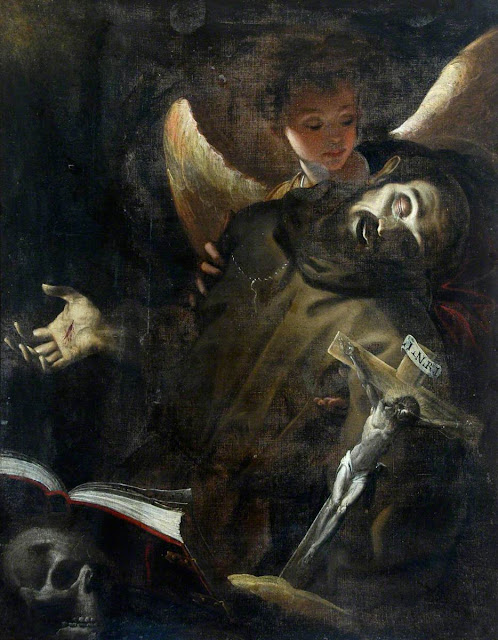Saint Francis in ecstasy Giovanni Crespi 1598
Saint Francis in Ecstasy by Giovanni Battista Crespi (1598), oil on canvas
Giovanni Battista Crespi, called Il Cerano, was an Italian painter, sculptor, and architect, born in Romagnano Sesia, the son of a painter, Raffaele Crespi, and moved to Cerano with his family some years later. True to the Counter-Reformation piety zealously expressed in Milanese art of his time, his paintings focus on mysteries and mystical episodes in saintly life. The crowded canvases and the angles recall Mannerism, but his paintings show an emotion that evokes common sentiments in Baroque art. Along with other artists, he completed a series of paintings (Quadroni of St. Charles) of the life of St. Charles Borromeo for the Duomo of Milan; an altarpiece with the Baptism of St. Augustine for San Marco, Milan; and a Mass of St. Gregory for the Basilica of San Vittore in Varese (1615–17). Also see the nightmarish, St. Gregory Delivers the Soul of a Monk (1617), also in San Vittore.
He was a scholar of considerable attainments and held a position of dignity in Cerano. In 1620 he was appointed the head of the Accademia Ambrosiana founded by Cardinal Federico Borromeo. Among his pupils were Daniele Crespi, Carlo Francesco Nuvolone, and Melchiorre Gherardini.
In 1586 Crespi went to Rome, where he stayed until 1595. While in Rome he formed a friendship with the Milanese cardinal, Federigo Borromeo, who became his patron and with whom he returned to Milan, then an important cultural centre and also, under the inspiration of the cardinal’s uncle, Archbishop Charles Borromeo, a centre of fervent spiritual revival in art. Crespi formed a style that was Mannerist in its use of colour—with an emphasis on pale, silvery tones—and in the mystical languidness of his figures. At the same time, his figures have a solidity and immediacy that move beyond Mannerism, and they are portrayed as unidealized types with realistic detail.
All Crespi’s works are characterized by an intense, often agonized spirituality. He executed several important church commissions, including a series of paintings of the life of St. Charles Borromeo for Milan Cathedral that was completed in 1610, a “Baptism of St. Augustine” for San Marco in Milan (1618), and a “Mass of St. Gregory” for the Basilica of San Vittore in Varese (1615–17), which, with its boldly unconventional composition, is reminiscent of the late 16th-century Venetian painter Tintoretto.
Crespi’s paintings from 1610 to 1620 are particularly impressive for their simplicity and for the humanization of the religious experiences that they portray; an example is “The Madonna of the Rosary”Italian painter, sculptor, engraver, architect, and writer, active mainly in Milan, where he was one of the leading artists of his time. He had settled there by the late 1590s, probably following a period in Rome, and became a protégé of Cardinal Federico Borromeo (cousin of St Charles Borromeo).
Borromeo, who was archbishop of Milan and an important art patron, appointed Crespi head of the painting section of the Accademia Ambrosiana, which he founded in 1620, and in 1629 put him in charge of the sculptural decoration of Milan Cathedral. Crespi's paintings, often mystical in feeling, are complex stylistically: there is a strong Mannerist current in his colouring and in the elegant posturing of his figures, but his work also shows a solidity and a feeling for realistic details that give it a place in the vanguard of the Baroque.






Comments
Post a Comment